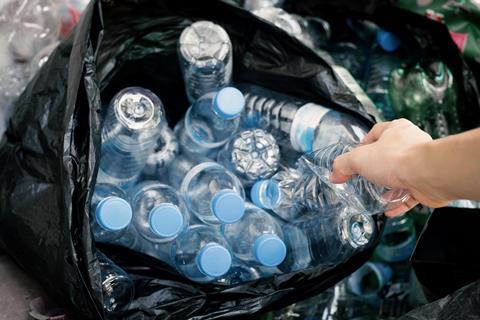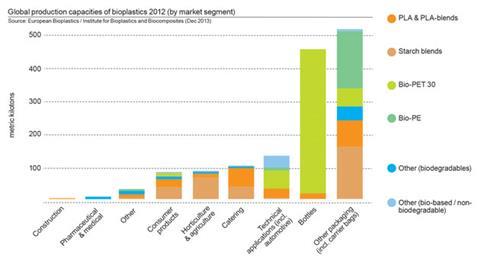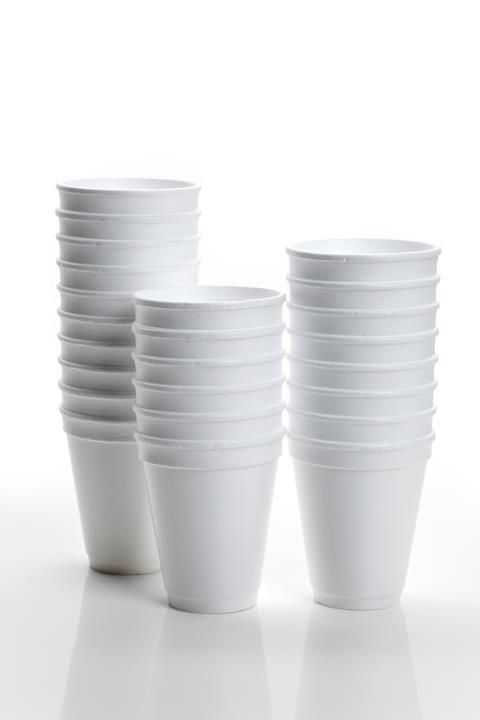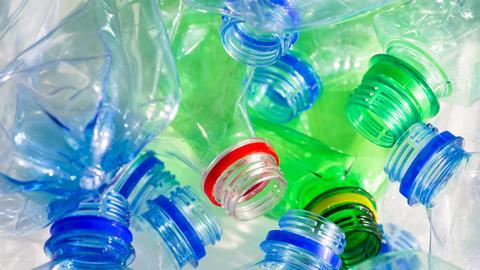Plastic packaging is ubiquitous, but uses precious resources and goes straight to waste. Bea Perks takes a look
Practically every type of plastic can be recycled. So what are we worrying about? Practically every type of plastic can indeed be recycled, if technical, logistic and economic factors are no object, but that is clearly not the case. The challenge of reducing our growing demand for plastic packaging is a complex one, involving politicians, manufacturers, environmentalists, consumers and, naturally, chemists.

Worldwide, there is a growing reliance on plastics, the dominant materials in industries from agriculture and electronics to medical devices and packaging. According to estimates published by the European trade association PlasticsEurope, global plastics production stood at 288 million tonnes in 2012, a 2.8% rise on the previous year. Overall, plastics consumption could grow to about 1 billion tonnes by the end of this century.1
The five most prevalent plastic types are polyolefins, polyvinyl chloride (PVC), polystyrene (PS), expanded polystyrene (EPS) and polyethylene terephthalate (PET). They currently account for about 70% of the total global demand, which is growing as populous countries like China and India become increasingly industrialised.
According to the British Plastics Federation, the UK uses over 5 million tonnes of plastic each year, of which an estimated 24% is currently being recovered or recycled. A whopping 2.4 million tonnes of this is packaging: 1.7 million tonnes from households and the rest from commercial and industrial companies. Household (or post-consumer) waste is largely made up of plastic bottles, pots, tubs, trays, films and plastic bags.
The zero landfill goal
In the US and across Europe, the amount of plastic waste generated from the domestic waste stream has grown rapidly, prompting the need for a more efficient and standardised approach to household waste collection. As a result, recycling has grown steadily over the last decade.
In 1960, plastics accounted for about 0.5% of American municipal solid waste generation.2 By 2010 this had risen to 12.4%. Too many plastics have single-use applications, and in many countries the end of life of these non-biodegradable materials has been disposal to landfill. A worldwide shortage of landfill sites is looming.

According to data presented last year at the K Trade Fair, the world’s largest plastics event, an average of 61.9% of post-consumer plastic waste was recovered across Europe in 2012, a 4% increase on 2011. This differs by country, with some recovering 100% of the post-consumer plastic waste they generate, and others collecting less than 30%. In total, 9 million tonnes of plastic waste were sent to landfill in Europe.
PlasticsEurope is aiming for zero plastics to landfill by 2020. ‘It is unacceptable that Europe buries the equivalent of €8 billion (£6.6 billion) a year by allowing 10 million tonnes of high calorific waste to be sent to landfills,’ says Karl-H Foerster, executive director of PlasticsEurope. ‘Better implementation and enforcement of existing waste legislation is crucial.’ Foerster recommends a ban on, or at least a phase-out of, the landfilling of recyclable and highly combustible waste. In countries with landfill bans, including Germany, Norway and Denmark, levels of waste recovery exceed 95%, he says.
Not only are we running out of places to put waste plastics, we are also in danger of running out of the ingredients needed to make them. Most plastics today are derived from crude oil, which also raises the issue of their greenhouse gas emissions. Making plastics from biological feedstocks, rather than fossil fuel, might offer a solution, but it remains unclear exactly how emissions would be cut. Jim Philp, science and technology policy analyst at the Organisation for Economic Co-operation and Development (OECD) has called for this to become a target for policy action, specifically regarding the methods for making the calculations, which are largely performed by life cycle assessment (LCA). LCA assesses the environmental impacts associated with all stages of a product’s lifetime, within set boundaries.
Many factors contribute to the emissions savings of both non-degradable, durable plastics derived from plant-derived carbon and truly biodegradable plastics, including the fossil fuels required in processing and water usage during fermentation. Each plastic is a case-by-case example. ‘That is where both the strengths and weaknesses of LCA become important,’ says Philp. ‘LCA only goes so far, and the results depend greatly on how the boundary conditions are set,’ he says, adding that the OECD is looking at the possibility of a similar tool for sustainability.
Philp suggests looking at end-of-life options. ‘In Japan, for example, a great deal of plastic waste is incinerated with energy recovery to make electricity,’ he says. ‘So a durable bio-based plastic could have a triple whammy: it is bio-based, thus renewable; it gets recycled one or more times; and then contributes to renewable energy generation.’
Bioplastics and biodegradation
Bioplastics encompass two separate but interlinked concepts: bio-based plastics representing the beginning of their lifespan; and biodegradable-compostable plastic representing the end. The term ‘bio-based’ refers to the use of carbon from biomass in place of fossil fuel carbon. ‘Its value proposition arises from removing carbon present as carbon dioxide in the environment and incorporating it into a polymer molecule via plant biomass photosynthesis in harmony with nature’s biological carbon cycle,’ says Ramani Narayan, professor of chemical engineering and materials science at Michigan State University in the US.

This is in contrast to plastics made from oil, coal or natural gas, which are formed from plant biomass over millions of years and so cannot be credited with removing any carbon dioxide from the environment, even over a 100 year timescale (the time period used in measuring global warming potential, GWP100). ‘This simple, fundamental, intrinsic value proposition is lost in an LCA analysis,’ says Narayan.
A cradle-to-gate LCA (where boundary conditions cover activities from the extraction of raw materials up to the factory gate) will show no advantage for the use of bio-based carbon because the boundary conditions are set from the extraction of the feedstock through the process of conversion to product. In this case, the LCA reports the carbon footprint of the process only.
‘Using basic stoichiometric equations one can show that every kilogram of bio-based PE [polyethylene] manufactured results in 3.14kg of carbon dioxide removed from the environment,’ says Narayan. ‘Similar stoichiometric calculations show that every kilogram of 100% bio-based PET manufactured results in 2.29kg of carbon dioxide removed from the environment.’ For the current bio-based PET plant bottle with 20% bio-based carbon content, he adds, 0.46kg of carbon dioxide is removed from the environment per kilogram of PET. For fossil fuel-based products, there would be no removal of carbon dioxide.
When feedstocks from fossil fuels are replaced by those from plants and other biomass, the resulting plastics are not necessarily biodegradable or compostable. To be completely biodegradable, they must degrade in the targeted disposal environment (in soil, compost or marine environments, or in an anaerobic digester) in a short, defined time period. They do not have to be made from biomass, but can be fossil fuel-based.
So not all bioplastics are biodegradable, and not all biodegradable plastics are bio-based. The use of renewable resources and the biodegradability or recyclability of the product are becoming important design criteria, opening up new market opportunities for developing biodegradable products.
Recycled PET bottles are used to make new plastic bottles and a range of other products from clothing to car parts. According to Wrap (the UK government-funded Waste and Resources Action Programme), 306,000 tonnes of plastic bottles were recycled through local authority collections in the UK in 2011, of which over half were PET. Chicago-based plastics recycling firm MRC Polymers estimates that 2.5 million plastic bottles are thrown away every hour in the US, with about 27% being recycled. Plastic bottle recycling in the US hit 1.2 million tonnes in 2012.
In July 2013, China and the US signed a cooperative partnership between Coca-Cola and the Yangtze River Delta Research Institute of Circular Economy to develop polyester production using Coke’s new PlantBottle packaging. Coca-Cola introduced the packaging – which it claims is the first-ever fully recyclable PET plastic bottle made partially from plants – in 2009, and has now distributed more than 15 billion bottles to 25 countries. It sounds an impossibly huge number, but only about 8% of the company’s PET plastic bottles contained PlantBottle technology last year. The plant-based part of the packaging comes from sugarcane-derived bio-monoethylene glycol, but within the next five to six years the company plans to use waste such as fruit peels, bark and stalks. Growing crops to make bioplastics throws up a host of ecological questions, and raises the issue of food price hikes as seen during the so-called tortilla riots in Mexico in 2007 (when US demands for corn, to make ethanol, forced prices sky high; see Against the grain).
Unexpected items in the bagging area
Controversially, there are also additive-containing plastics that are claimed to be biodegradable using so-called oxo and organic additives added at 1–2% levels to conventional PE, polypropylene, PS, PET or other plastics.
These are championed by the Oxo-biodegradable Plastics Association (OPA). Oxo-biodegradable plastics are conventional polyolefins with small amounts of metal salts added. According to the OPA, these salts catalyse the natural degradation process so that the plastic degrades abiotically at the end of its useful life in the presence of oxygen. At the end of that process it is no longer visible to the naked eye, it is no longer a plastic, and will then biodegrade. Bio-based plastics need too much fossil fuel energy for their production, claims the OPA, and take too long to degrade.
Biodegradability claims made for oxo-biodegradable plastics remain unsubstantiated by competent and reliable scientific evidence using international standards, says Narayan. It must be proven that microorganisms present in the disposal environment are using the plastic carbon substrate in a defined and measurable time period.
‘Stating that these will eventually biodegrade, or showing microbial growth or physical and chemical degradation, does not prove that all of the plastic carbon substrate will be removed from the environment via microbial metabolism’, says Narayan. ‘Basic high school biochemistry/biology teaches us how to experimentally measure the amount of carbon being consumed by the microorganisms … so it should be easy to establish the rate and extent of biodegradability.’ Claims of biodegradability must be qualified by providing information on the disposal environment, the amount biodegraded and the time to reach that level of biodegradation, says Narayan. ‘Extrapolation of data is very misleading,’ he concludes.
Narayan isn’t alone in questioning oxo-plastics. The effect of the ‘invisible’ plastic following oxo-plastic degradation, so-called microplastics, on human health and the environment remain unknown, according to the European environment commissioner Janez Potocnik. Hazardous plastics will be covered as a topic in the European commission’s all-encompassing waste review package expected in May (see Europe wants to get tough on plastic waste).
Storm in a coffee cup

Controlling the production of ubiquitous packaging needs close negotiation with those who make, supply and use these products. In the US, a weighty defence has raged against bans on EPS foam packaging (known in the US as Styrofoam, although technically this applies to an extruded polystyrene foam made by Dow). EPS packaging, though perfectly recyclable according to the American Chemistry Council (ACC), is rarely recycled and does not break down in nature. A US study in Monterey Bay, California, found that EPS foam made up 41% of the total beach litter.3 At the end of 2013, New York city announced a ban on EPS foam cups that will come into force in 2015. Similar bans have been passed in other US cities, including San Francisco and Seattle. Chicago is also proposing a ban on the containers (Senate Bill #568), although it can expect a fight with the ACC.4
‘The technology exists to recycle polystyrene foam foodservice right now,’ said ACC vice-president of plastics, Steve Russell, in response to news of New York’s polystyrene packaging ban. ‘California is making this work – 22% of households there can recycle polystyrene foam foodservice cups, plates, bowls, and other containers at the curbside.’
EPS, in sufficient quantities, can be cleaned and converted into pellets that can then be used to make products like coat hangers. The recycling company Enviro, based in the UK sea-fishing port Grimsby, compacts used polystyrene fish boxes, before exporting them to the far east where they are recycled and turned into products including disposable cameras. Polystyrene is much easier to recycle when it’s just polystyrene. One reason often given for the absence of post-consumer PS recycling in Europe or the US is that it tends to break into small parts that are difficult to separate from the rest of the waste.
Plastic bags at dawn
The debate over plastic bags is fiercer still. What should they be made of and – more likely to raise a few hackles – should we be charged for using them? In September 2013, the UK government announced a 5p charge for supermarket plastic bags from 2015. Similar charges are already in place in Northern Ireland and Wales, and Northern Ireland is planning to raise the price to 10p following an 80% reduction in bag use with the 5p charge. Scotland will start charging for bags from October 2014.

The British Plastics Federation (BPF) is quite clear on this. ‘The UK plastics industry opposes the idea of a plastic bag tax on principle, because it would unfairly discriminate against plastic materials and is based on a misinterpretation of the relationship between materials, the environment and the causes of litter.’
The BPF notes that plastic bags are listed in the European directive 2004/12/EC on packaging and packaging waste,5 and that further national measures would go against the spirit of harmonised producer–responsibility legislation across Europe. The directive is aimed at limiting the production of packaging waste and promoting its recycling and reuse. The UK government is currently discussing with industry the way it delivers this legislative framework through its Producer Responsibility Regulations, and will post progress updates on the Environment Agency website in the coming months.
In 2002, Ireland became the first country to issue a plastic bag levy. Results from the country’s National Litter Pollution Monitoring System show that, in 2012, plastic bags constituted 0.3% of litter nationally compared to an estimated 5% prior to the introduction of the levy.
The BPF, which holds up plastic bags as a ‘social·economic and environmental success story’ questions the Ireland data, with the observation that members of the Irish grocery association, RGDATA, have lost an estimated €5600 per outlet as a result of stolen wire baskets and trolleys.
It is hardly surprising that the producers of plastic packaging campaign against restrictions on their use. But it remains far from clear how the problems faced – increasing demands for plastics, decreasing resources for their production and decreasing options for their disposal – can be solved. The one piece of advice agreed by all industrial, environmental and consumer bodies is that we need to use less packaging. Reusing plastic bags, pots and tubs is nearly always going to be more efficient than throwing them in a recycling bin (although beware of self-destructing degradable bags).
References
1 J C Philp, R J Ritchie and K Guy, Trends Biotechnol., 2013, 31, 65 (DOI: 10.1016/j.tibtech.2012.11.009)
2 Bio-based plastics: materials and applications, ed. Stephan Kabasci, Wiley, 2013
3 C Rosevelt et al, Pollut. Bull., 2013, 71, 299 (DOI: 10.1016/j.marpolbul.2013.01.015)
4 ACC statement, November 25, 2013, http://rsc.li/1gRZk4H
5 Directive 2004/12/EC of the European parliament, 11 February 2004, http://rsc.li/1gRZok













No comments yet